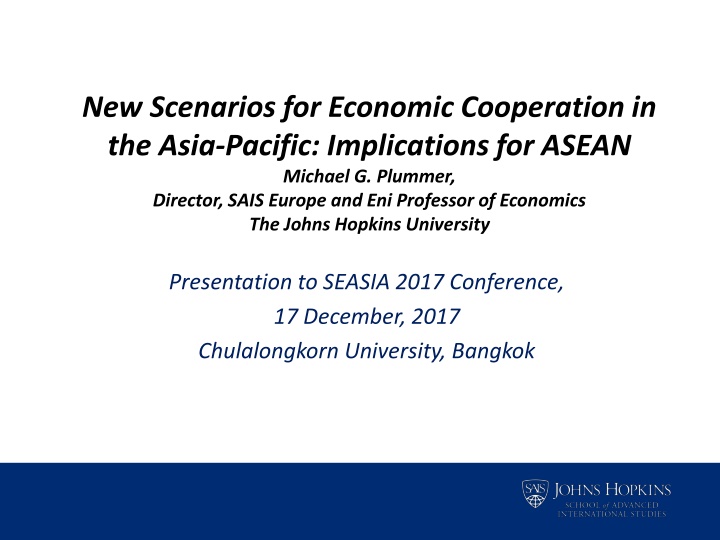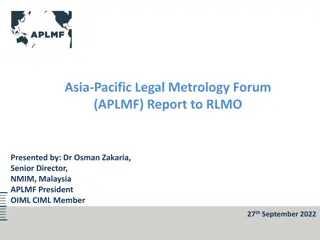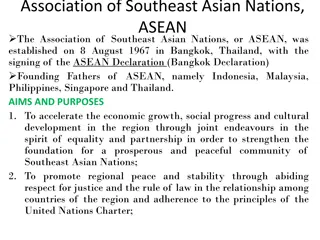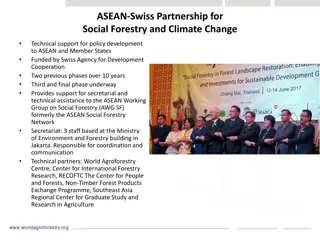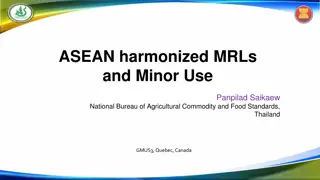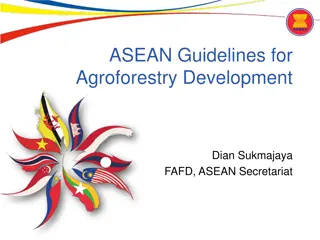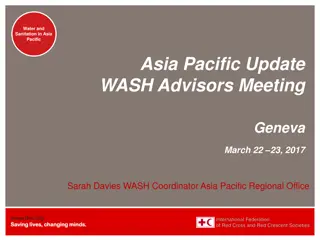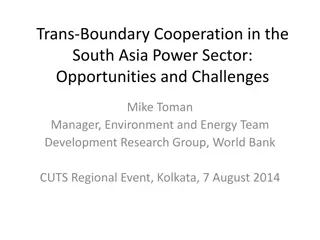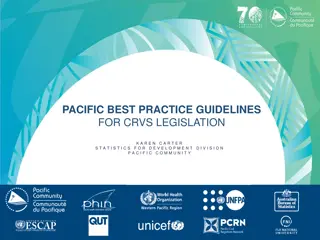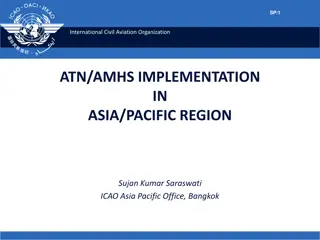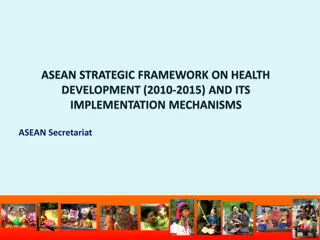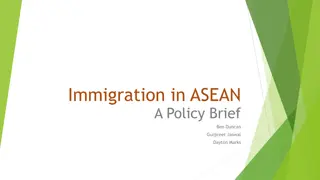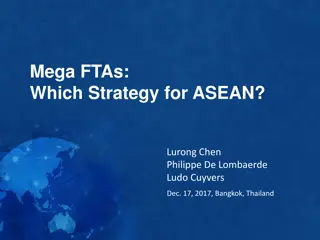New Scenarios for Economic Cooperation in Asia-Pacific: Implications for ASEAN
Delve into the evolving landscape of economic cooperation in the Asia-Pacific region and its impact on ASEAN. Explore the role of megaregional trade agreements, such as TPP and RCEP, in shaping future collaborations. Gain insights into the potential for deeper integration through initiatives like CPTPP and RCEP and the benefits and challenges they pose for ASEAN economies.
Download Presentation

Please find below an Image/Link to download the presentation.
The content on the website is provided AS IS for your information and personal use only. It may not be sold, licensed, or shared on other websites without obtaining consent from the author.If you encounter any issues during the download, it is possible that the publisher has removed the file from their server.
You are allowed to download the files provided on this website for personal or commercial use, subject to the condition that they are used lawfully. All files are the property of their respective owners.
The content on the website is provided AS IS for your information and personal use only. It may not be sold, licensed, or shared on other websites without obtaining consent from the author.
E N D
Presentation Transcript
New Scenarios for Economic Cooperation in the Asia-Pacific: Implications for ASEAN Michael G. Plummer, Director, SAIS Europe and Eni Professor of Economics The Johns Hopkins University Presentation to SEASIA 2017 Conference, 17 December, 2017 Chulalongkorn University, Bangkok
Takeaways International trade has played a critical role in poverty reduction, growth, and development in ASEAN, creating powerful constituencies for concerted commercial policy reforms. With an impasse at the DDA, megaregionalism (TPP, RCEP) has emerged as a potential force due to economic priorities of the region. Via the TPP, the US led the process of Asia-Pacific megaregionalism but it withdraw from the accord in January. The remaining countries, however, agreed in principle last month to create the CPTPP. It is likely the first step in a process toward deeper integration. In our recent paper, we estimate the economic effects of various initiatives, including TPP/CPTPP configurations and RCEP. This presentation also adds CPPTPP+RCEP scenarios, which may define the path to FTAAP. The overall effects of these initiatives are large and increasing in additional members, with gains driven by trade. New rules become global standards. The mega-regionalism trend should benefit ASEAN economies significantly, but raises the stakes for ASEAN cooperation.
Trade is Good for Growth and Development Outward orientation has been a key characteristic of Asian development, despite differing sequencing and depth. Indeed, empirical work over the past two decades confirms that trade has a highly positive effect on growth and development: Trade leads to growth; trade-induced growth leads to improved employment in medium-long run. Particularly relevant to developing economies with unemploy/underemployment and/or large informal sector, as in much of ASEAN. Trade has important productivity spillovers via exports, imports and links to FDI (e.g., OECD 2012). Trade reduces poverty (Winters, et. al, 2004) but beware context! Production networks driving trade in Asia have great potential to plug LICs into the regional and global economies, help SMEs, and reduce poverty as well (e.g., ADB 2008, AEC Blueprint) Macro environment and other policies that create greater stability and improve the lot of the poor need to be prioritized.
Need for New Policy Approaches In sum, while structural adjustment entails short-term costs to be addressed, the empirical evidence is quite solid. Integration underscores the need for an enlightened public policy to facilitate this adjustment and protect the most vulnerable. The DDA single-undertaking remains elusive (no breakthroughs expected in Argentina!), all major economies and most smaller economies have expressed interest in free-trade areas in words and deeds, as evidenced by the rise in RTAs. In Asia, these new RTAs are being designed for economic, political and strategic reasons.
Why Megaregionals? Doha challenges, strategy and politics --> RTAs Spaghetti-bowl consequences --> MRTAs Traditional RTA concerns are exaggerated Empirical evidence suggests trade creation over trade diversion Despite RTA trend, global trade and FDI are expanding RTAs improve over time Effective RTAs typically grow Competitive liberalization drives RTAs to improve Diversion costs of RTAs stimulate MFN liberalization We define MRTAs to be RTAs that have a systemic, global impact (e.g., TPP/CPTPP, RCEP, FTAAP).
Internationalization Trends 60 100 90 50 80 Share of Global Trade, Percent 70 Trade to GDP ratio, Percent 40 60 30 50 40 20 30 20 10 10 0 0 1995 Advanced Economies (R axis) Other (R axis) Low-Income Countries (L axis) 1997 1999 2001 2003 2005 2007 2009 2011 2013 Emerging Market Economies (R axis) Advanced Economies (L axis) Low-Income Countries (R axis) Emerging Market Economies (L axis)
How did past FTAs affect trade? Increase in Intra-trade Authors Dataset Special features World Bank GEP 2005 (2005) 120% 17 research studies Meta-analysis, mostly na ve models Cippolina & Salvatici REStat (2010) 84% 1460 estimates Meta-analysis, cross-section and individual FTA studies Head & Mayer Handbook (2014) 43% - 80% 108 257 estimates Meta-analysis, na ve and structural models Baier et al. CESifo WP (2016) 70% 1965-2010, every 5 years Panel, general equilibrium, endogenous FTA, two margins Egger et al. Am Ec J (2016) 215% - 255% CEPII 2005 General equilibrium, endogenous FTA Lim o Handbook (2016) 82% 5-year panel 1965-2010 General equilibrium, dynamic, endogenous FTA Authors
Asian and TPP tracks FTAAP RCEP Russia United States Canada Chile Mexico Peru Australia Brunei Japan Malaysia New Zealand Singapore Vietnam Cambodia China Laos Myanmar India Indonesia Korea Philippines Thailand TPP 11 TPP 16 Taiwan Slide 11
Notes on CPTPP and RCEP Templates RCEP was officially created in November 2012, slated to be finished in 2015, now 2018. Recent progress has been ostensibly good, but will be a modest agreement. CPTPP is remarkably similar to TPP (20 suspended measures; mostly IPR; all US priorities!). TPP/CPTPP is more focused on comparative advantage of advanced economies: services, investment, intellectual property, than to be expected from the RCEP. Still, the RCEP has ambitious goals, with many of the same areas being covered under CPTPP albeit with the idea of greater flexibility and SDT. It will be more focused on comparative advantage of its developing economies. The modern interpretation of the Yokohama Vision (2010) suggests that the CPTPP and RCEP tracks should converge in the FTAAP. We characterize this in our CPTPP+RCEP simulations. Slide 12
Methodology Model 18-sectors, 24-regions CGE Innovations Baseline projections look ahead to 2030 Detailed analysis of existing and future trade agreements Firms differ in productivity (Melitz model) Investment effects (albeit from side-model) Previous work reported: www.asiapacifictrade.org New Asia-Pacific Scenario simulations found at PIIE Website: Going it Alone in the Asia-Pacific: Regional Trade Agreements without the United States (Petri, Plummer, Zhai and Urata) First time: TPP+RCEP Scenarios Slide 13
Effects of modeling innovations Some innovations raise trade and income estimates Scale and Melitz effects increase productivity More varieties become available Some innovations lower trade and income estimates Existing agreements are taken into account Barriers are only partially removed Preferences are only partially used ROOs raise costs Slide 14
Income Changes in CPTPP-RCEP Scenarios (Petri, Plummer, Zhai and Urata) Change in $bill. CPTPP 49 -2 69 1 -10 -1 21 0 13 -5 11 0 15 14 12 147 2030 income 39.569 25.754 50.659 31 27.839 2.192 675 680 485 812 497 283 2.854 40.720 23.189 133.801 TPP12 208 131 202 2 -18 -2 52 -1 19 -7 41 -1 21 60 48 492 CP16 72 -6 316 1 -53 18 36 13 19 30 25 0 22 39 22 449 RCEP 2 1 253 0 101 1 6 1 2 3 2 1 7 23 16 286 CP+R 50 -2 305 1 89 0 24 1 15 -1 12 1 19 34 25 408 C16+R 73 -5 514 1 51 17 39 13 19 31 26 0 26 54 33 667 Americas United States Asia Brunei China Indonesia Malaysia Philippines Singapore Thailand Vietnam ASEAN nie Oceania Rest of World Europe WORLD Memorandum (members) (non-memb) 465 27 157 -10 486 -37 261 24 375 32 616 50
Export Changes in CPTPP and RCEP Scenarios (Petri, Plummer, Zhai and Urata) Change in $bill. CPTPP 72 -10 172 1 -9 -3 42 0 29 -7 31 0 28 14 8 287 2030 exports TPP12 478 357 511 1 9 -4 99 -1 35 -9 107 -3 38 79 49 1.106 CP16 103 -22 874 1 -44 49 71 29 33 68 84 -1 45 10 -7 1.032 RCEP -1 3 668 0 259 17 17 4 3 24 17 4 17 -7 -9 677 CP+R 70 -8 810 1 246 15 56 4 31 19 46 3 41 6 -2 927 C16+R 104 -19 1.377 1 212 59 78 30 32 77 88 2 51 4 -14 1.537 Americas United States Asia Brunei China Indonesia Malaysia Philippines Singapore Thailand Vietnam ASEAN nie Oceania Rest of World Europe WORLD Memorandum (members) 7.068 3.906 12.905 16 4.976 446 491 184 470 561 357 93 673 15.503 9.706 36.149 1.025 308 1.102 692 934 1.550 (non-memb) 81 -22 -70 -15 -7 -13
Highlights Effects of CPTPP are smaller than TPP12--no member does better in CPTPP but significant. Importance of high-quality nature of TPP: help reform programs from Vietnam to Japan. Best seen as a pathway: CPTPP to CPTPP16 (results for members are even bigger than TPP12) to CPTPP+RCEP. Strong income effects are driven by exports. RCEP alone is shallow but big: effects are only about 2/3 CPTPP16 effects. CPTPP+RCEP effects are large and almost additive, due in part to TPP rules applied to RCEP relationships.
Implications for ASEAN ASEAN countries are actively involved in both mega-regionals. Potential economic gains are significant. TPP/CPTPP and RCEP templates are consistent, but the former will likely be far more comprehensive than the latter. Given diversity, two tracks makes sense (Petri and Plummer 2014). But strong case can be made for ASEAN Centrality . This entails many things; in terms of economics, need to complete the AEC and the ASEAN Community Vision 2025. FTAAP, based on a comprehensive template, should be the ultimate goal; CPTPP/RCEP are pathways.
Concluding Remarks: What Seiji Would Say Several of us here worked with the great Seiji Naya very closely and for many years. I certainly don t have a monopoly on projecting what Seiji would say about all this, but I can take a good guess. He was a key protagonist of ASEAN integration and would have cheered the establishment of the AEC. But he taught me that ASEAN statements come well before facts on the ground and much remains to be done. Still, it is the good fight. For almost a half-century he pushed for deeper US-ASEAN/Asian cooperation. He would have been devasted by the direction of the current US government in general and its withdrawal from the TPP in particular. Still, he would have seen hope in the CPTPP moving forward. And he would have never given up on US participation in the process of Asian integration. After all, Seiji was a fighter: both figuratively and literally (as a Golden Glove boxer). We miss him deeply, as teacher, mentor and friend. His fundamental contributions to ASEAN economic cooperation and building the Asia-Pacific Community have helped bring us to this point. Let us continue to take up the torch!
THANK YOU! I look forward to discussion Papers can be found at: www.asiapacifictrade.org
